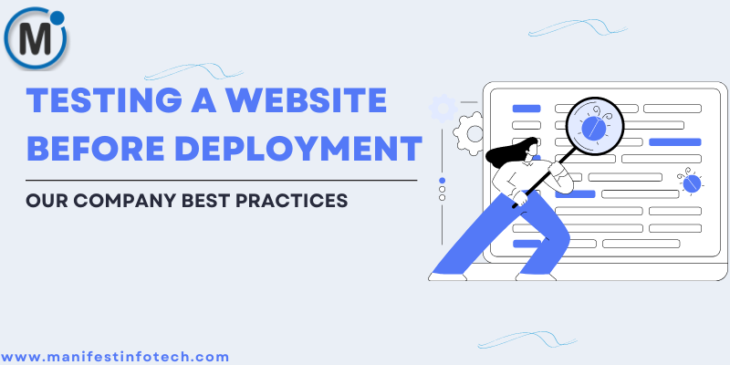
At our Company Manifest Infotech, we follow the best practices as shared below:
𝟏. 𝐅𝐮𝐧𝐜𝐭𝐢𝐨𝐧𝐚𝐥 𝐓𝐞𝐬𝐭𝐢𝐧𝐠:
– Test all links to make sure they lead to the correct pages.
– Test forms, including submitting data, validation, and error handling.
– Ensure navigation elements (menus, buttons, etc.) work as intended.
– Test interactive features such as sliders, carousels, and accordions.
𝟐. 𝐂𝐨𝐦𝐩𝐚𝐭𝐢𝐛𝐢𝐥𝐢𝐭𝐲 𝐓𝐞𝐬𝐭𝐢𝐧𝐠:
– Test the website on different browsers (Chrome, Firefox, Safari, Edge, etc.).
– Test on various devices (desktops, tablets, smartphones) to ensure responsiveness.
– Check compatibility on different operating systems (Windows, macOS, iOS, Android).
𝟑. 𝐏𝐞𝐫𝐟𝐨𝐫𝐦𝐚𝐧𝐜𝐞 𝐓𝐞𝐬𝐭𝐢𝐧𝐠:
– Test the website’s loading speed on different connections (3G, 4G, Wi-Fi).
– Use tools like Google PageSpeed Insights or GTmetrix to identify performance bottlenecks.
– Optimize images, scripts, and CSS to improve loading times.
𝟒. 𝐔𝐬𝐚𝐛𝐢𝐥𝐢𝐭𝐲 𝐓𝐞𝐬𝐭𝐢𝐧𝐠:
– Conduct user testing to gather feedback on the website’s usability and user-friendliness.
– Identify any user experience issues and make necessary improvements.
– Ensure that the website is intuitive and easy to navigate.
𝟓. 𝐒𝐞𝐜𝐮𝐫𝐢𝐭𝐲 𝐓𝐞𝐬𝐭𝐢𝐧𝐠:
– Perform security scans to identify vulnerabilities (SQL injection, XSS, CSRF, etc.).
– Ensure proper encryption (SSL) is implemented for data transmission.
– Validate user inputs to prevent malicious code injection.
𝟔. 𝐂𝐨𝐧𝐭𝐞𝐧𝐭 𝐕𝐚𝐥𝐢𝐝𝐚𝐭𝐢𝐨𝐧:
– Check for spelling, grammar, and formatting errors in all content.
– Ensure that all images, videos, and media files are displayed correctly.
– Verify that content is up-to-date and accurate.
𝟕. 𝐀𝐜𝐜𝐞𝐬𝐬𝐢𝐛𝐢𝐥𝐢𝐭𝐲 𝐓𝐞𝐬𝐭𝐢𝐧𝐠:
– Test the website for accessibility compliance (WCAG) for users with disabilities.
– Ensure that proper alt text is provided for images and other non-text content.
– Test keyboard navigation and screen reader compatibility.
𝟖. 𝐃𝐚𝐭𝐚𝐛𝐚𝐬𝐞 𝐓𝐞𝐬𝐭𝐢𝐧𝐠:
– Validate that data is stored and retrieved accurately from the database.
– Test data integrity and consistency across different parts of the website.
𝟗. 𝐄𝐫𝐫𝐨𝐫 𝐇𝐚𝐧𝐝𝐥𝐢𝐧𝐠 𝐚𝐧𝐝 𝐑𝐞𝐜𝐨𝐯𝐞𝐫𝐲 𝐓𝐞𝐬𝐭𝐢𝐧𝐠:
– Test how the website handles errors, such as 404 pages or server errors.
– Ensure that error messages are user-friendly and provide guidance on how to proceed.
𝟏𝟎. 𝐂𝐫𝐨𝐬𝐬-𝐅𝐮𝐧𝐜𝐭𝐢𝐨𝐧𝐚𝐥 𝐓𝐞𝐬𝐭𝐢𝐧𝐠:
– Test scenarios that involve multiple features interacting with each other.
– Check how the website behaves when transitioning between different sections.
𝟏𝟏. 𝐕𝐞𝐫𝐬𝐢𝐨𝐧 𝐂𝐨𝐧𝐭𝐫𝐨𝐥 𝐚𝐧𝐝 𝐑𝐨𝐥𝐥𝐛𝐚𝐜𝐤 𝐏𝐥𝐚𝐧:
– Use version control systems (e.g., Git) to manage code changes.
– Have a rollback plan in place in case deployment issues arise.
𝟏𝟐. 𝐒𝐭𝐚𝐠𝐢𝐧𝐠 𝐄𝐧𝐯𝐢𝐫𝐨𝐧𝐦𝐞𝐧𝐭 𝐓𝐞𝐬𝐭𝐢𝐧𝐠:
– Test the website in a staging environment that closely resembles the production environment.
– Address any issues before deploying to the live site.
If you are looking for any services related to Website Development, App Development, Digital Marketing and SEO, just email us at nchouksey@manifestinfotech.com or Skype id: live:76bad32bff24d30d
𝐅𝐨𝐥𝐥𝐨𝐰 𝐔𝐬:
𝐋𝐢𝐧𝐤𝐞𝐝𝐢𝐧: linkedin.com/company/manifestinfotech
𝐅𝐚𝐜𝐞𝐛𝐨𝐨𝐤: facebook.com/manifestinfotech/
𝐈𝐧𝐬𝐭𝐚𝐠𝐫𝐚𝐦: instagram.com/manifestinfotech/
𝐓𝐰𝐢𝐭𝐭𝐞𝐫: twitter.com/Manifest_info
#WebsiteTesting #WebDeployment #QualityAssurance #TestingBestPractices #WebDevTesting #UXTesting #BugFreeDeployment #WebsiteQuality #TestingStrategy #WebPerformance #UserExperience #CodeReview #SiteTesting #DeploymentPrep #WebTestingTips #FunctionalTesting #CompatibilityTesting #PerformanceTesting #UsabilityTesting #SecurityTesting #AccessibilityTesting #DatabaseTesting #ErrorHandlingTesting #CrossFunctionalTesting #VersionControl #StagingEnvironment #TestingProcess #DeploymentChecklist #QualityControl #TestAndDeploy